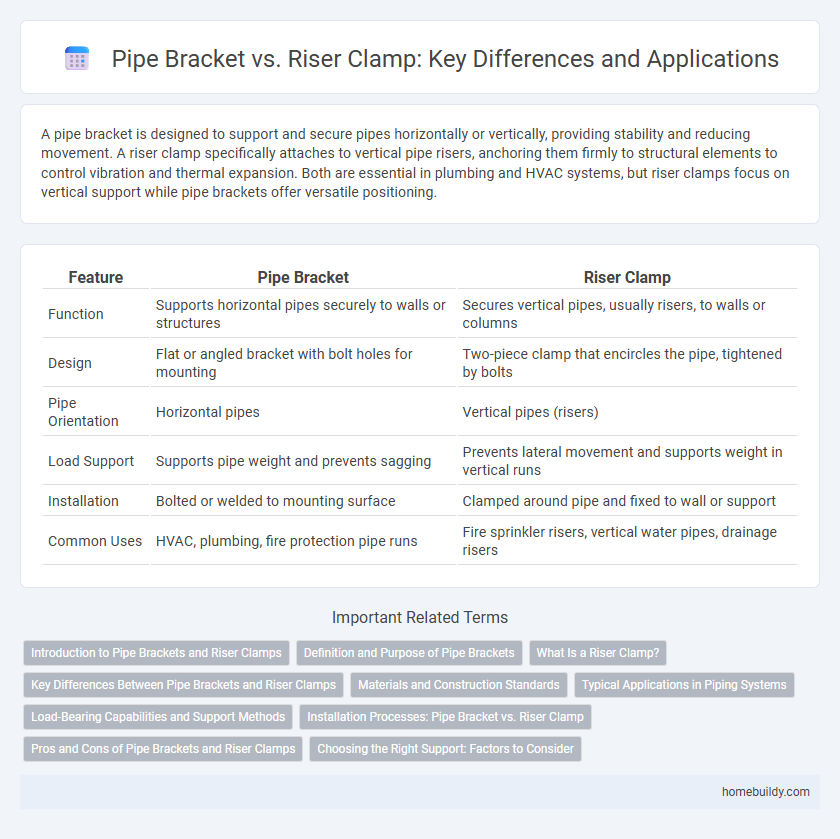A pipe bracket is designed to support and secure pipes horizontally or vertically, providing stability and reducing movement. A riser clamp specifically attaches to vertical pipe risers, anchoring them firmly to structural elements to control vibration and thermal expansion. Both are essential in plumbing and HVAC systems, but riser clamps focus on vertical support while pipe brackets offer versatile positioning.
Table of Comparison
| Feature | Pipe Bracket | Riser Clamp |
|---|---|---|
| Function | Supports horizontal pipes securely to walls or structures | Secures vertical pipes, usually risers, to walls or columns |
| Design | Flat or angled bracket with bolt holes for mounting | Two-piece clamp that encircles the pipe, tightened by bolts |
| Pipe Orientation | Horizontal pipes | Vertical pipes (risers) |
| Load Support | Supports pipe weight and prevents sagging | Prevents lateral movement and supports weight in vertical runs |
| Installation | Bolted or welded to mounting surface | Clamped around pipe and fixed to wall or support |
| Common Uses | HVAC, plumbing, fire protection pipe runs | Fire sprinkler risers, vertical water pipes, drainage risers |
Introduction to Pipe Brackets and Riser Clamps
Pipe brackets and riser clamps serve essential roles in securing piping systems, with pipe brackets providing sturdy support for horizontal pipe runs while riser clamps are specifically designed to stabilize vertical risers. Pipe brackets typically feature a rigid structure that distributes weight evenly, reducing pipe movement and wear. Riser clamps, on the other hand, ensure vertical pipes remain aligned and prevent sagging, contributing to overall system integrity and safety.
Definition and Purpose of Pipe Brackets
Pipe brackets are structural supports designed to secure and stabilize pipes along walls or ceilings, ensuring proper alignment and load distribution. Unlike riser clamps, which primarily provide vertical support for vertical pipe runs by gripping around the pipe, pipe brackets offer versatile attachment points that accommodate horizontal or angled piping layouts. Their purpose centers on maintaining pipe integrity under stress, reducing vibration, and preventing displacement in plumbing, HVAC, and industrial piping systems.
What Is a Riser Clamp?
A riser clamp is a specialized pipe support device designed to secure vertical pipes, preventing movement and minimizing stress on the piping system. Unlike a pipe bracket, which can be used for both horizontal and vertical pipe support, a riser clamp specifically grips the pipe circumference, often featuring a bolted design for easy installation and adjustment. It is commonly used in plumbing, heating, and fire sprinkler systems to stabilize riser pipes and maintain structural integrity.
Key Differences Between Pipe Brackets and Riser Clamps
Pipe brackets provide stable lateral support for horizontal pipe runs, preventing sagging by securing pipes to walls or structures. Riser clamps are specifically designed to support vertical pipes, absorbing the weight of the pipe and preventing movement in riser applications. The key difference lies in their orientation and load-bearing function: pipe brackets stabilize horizontal pipes, while riser clamps manage vertical pipe loads.
Materials and Construction Standards
Pipe brackets are typically fabricated from carbon steel, stainless steel, or galvanized steel, providing robust support for piping systems in various environments. Riser clamps, while also constructed from similar metals, often include rubber lining to protect vertical pipes from vibration and damage. Construction standards for pipe brackets follow ASTM A36 or A53 for steel, whereas riser clamps adhere to ASME B31.1 or B31.3 codes, ensuring compliance with pressure piping requirements.
Typical Applications in Piping Systems
Pipe brackets provide secure support for horizontal pipes, preventing sagging and maintaining alignment in various industrial and commercial piping systems. Riser clamps are specifically designed for vertical pipe runs, offering stability and load distribution to minimize stress on risers in high-rise buildings and process plants. Both components are essential in ensuring structural integrity and efficient load management in complex piping networks.
Load-Bearing Capabilities and Support Methods
Pipe brackets and riser clamps differ significantly in load-bearing capabilities and support methods; pipe brackets are designed to provide robust structural support by distributing weight evenly along the pipe's length, making them ideal for heavier loads and dynamic stress conditions. Riser clamps primarily secure vertical piping systems by clamping around the pipe to prevent lateral movement but generally offer less load distribution capacity compared to pipe brackets. The choice between them depends on the application's load requirements and whether the pipe runs vertically or horizontally, influencing the overall stability and longevity of the piping system.
Installation Processes: Pipe Bracket vs. Riser Clamp
Pipe brackets typically offer a straightforward installation process involving secure mounting to walls or ceilings with screws and anchors, ensuring stable support for horizontal or vertical pipes. Riser clamps require precise alignment around vertical pipes and usually fasten directly to structural members, providing robust load distribution and vibration resistance. The choice between the two depends on pipe orientation, load requirements, and ease of access during installation.
Pros and Cons of Pipe Brackets and Riser Clamps
Pipe brackets provide strong lateral support for pipes, making them ideal for horizontal installations but may require more space compared to riser clamps. Riser clamps excel in vertical pipe stabilization with easy adjustable fittings, though they might offer less resistance to lateral movement. Choosing between pipe brackets and riser clamps depends on the specific pipe orientation, load requirements, and installation environment.
Choosing the Right Support: Factors to Consider
Pipe brackets and riser clamps both provide essential support for pipes, but the choice depends on load capacity, pipe size, and installation environment. Pipe brackets are ideal for horizontal runs, offering stability and ease of adjustment, while riser clamps excel in vertical support with secure gripping to prevent pipe movement. Considering factors like pipe material, weight, and vibration levels ensures optimal selection for long-term durability and safety.
pipe bracket vs riser clamp Infographic

 homebuildy.com
homebuildy.com